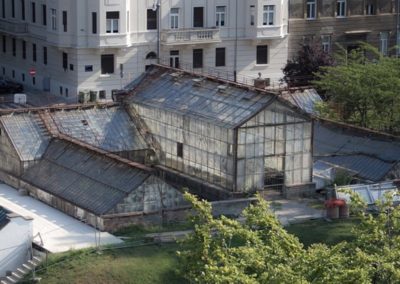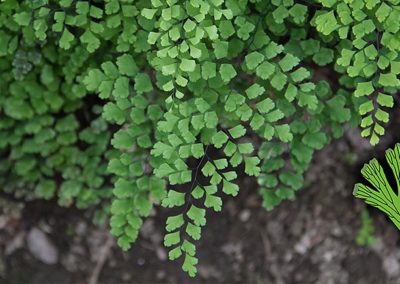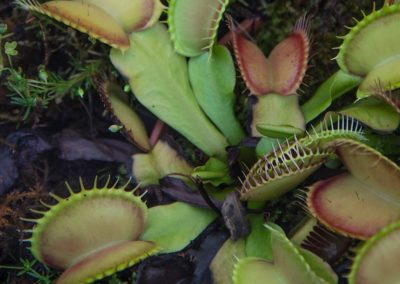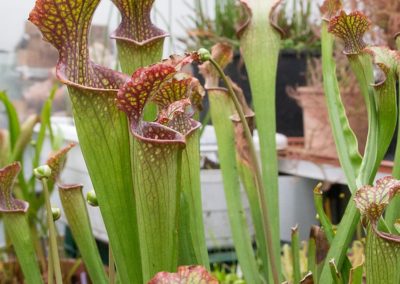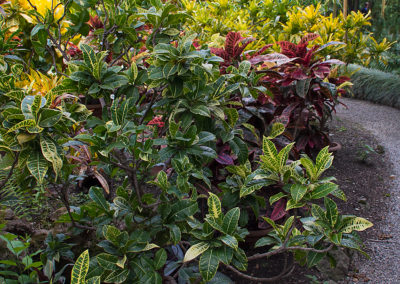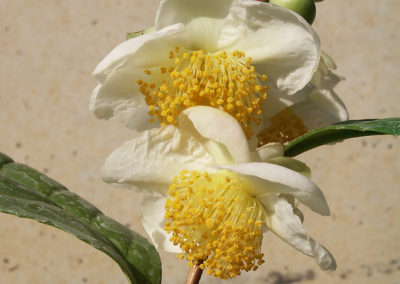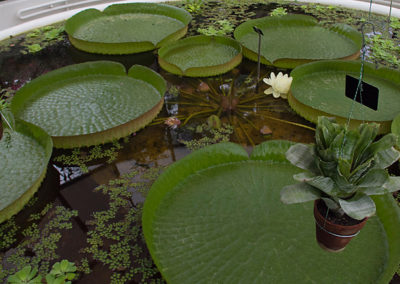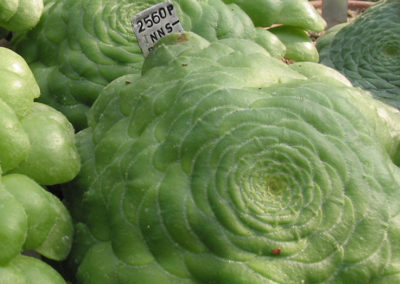

Greenhouses
After the construction of the world’s first greenhouse (1840), exhibition greenhouse gradually became an integral part of every larger botanical garden. It can be said that in the 19th and the beginning of the 20th century, the value of botanical gardens was judged by the size of their collections of tropical plants exhibited in their greenhouses. This is also reason why greenhouses were built in our Botanical Garden immediately after its establishment. Although they have been in use for more than a century, they have never been restored. The central greenhouses, built in 1891, form a single unit with the parterre. They are a valuable example of a specific architectural heritage. Unfortunately, this unique building, the only one of its kind preserved in Croatia, is also the only central building in the city’s ‘Green Horseshoe’ which has not, as yet, been restored. The restoration of the exhibition greenhouse will contribute to the integrity of the historical architectural heritage in the green part of Donji grad (the central, lower part of the city). At the same time, it will give the citizens a new opportunity to see tropical species grown in a closed space.
The term ‘greenhouse’, a specific building for cultivation and display of living plants, in Croatian ‘staklenik’ (direct translation: ‘glasshouse’), is of newer date, being used in literature since 1900s. Until then other terms were more common, e.g. ‘toplik’ (‘warmhouse’), ‘bilinjak’ (‘planthouse’) and others.
The basic concept of the restoration project prepared by conservation architect Mladen Perušić presupposes the greenhouse’s original shape. The distribution of tropical plants inside the greenhouse will follow the scheme identical to the original one and parts of the greenhouse will keep their original names. The only novelty will be the Shaded House, envisaged to be built in one part of the basement. There, the visitors will be able to see tropical and sub-tropical plants growing naturally in the shade of tall trees festooned mostly with epiphytes such as various ferns and bromeliads, and diverse climbers growing on both trees and moist rocks.
Warm greenhouses
Ferns and spikemosses
In the collection of about 40 tropical and sub-tropical pteridophytes, some are more than 50 years old. Among the most interesting ones are the Hare’s foot fern (Davallia solida ‘Superba‘), native to Malaysia, the Japanese Holly fern (Cyrtomium (Polypodium) falcatum), a popular ornamental plant found in warm climates, and a few cultivars of the Common sword fern (Nephrolepis (Aspidium) exaltata). During the restoration of the exhibition greenhouse, the ferns spend the summers outdoors in what we refer to as the Fernarium. A small collection of spikemosses (Selaginellaceae), ancient and primitive group of vascular plants, are mostly tropical plants and require high temperature and humidity so they are constantly cultivated in the warm greenhouse.
One species of fern, a Maidenhair fern (Adiantum capillus-veneris) spontaneously grows on the walls of several greenhouses, and was therefore chosen to be the logo of the Garden (not the entire frond, just a small section of it).
Carnivorous plants
Carnivorous plants mostly live on very nutrient-poor soils (usually in bogs, in water, on rocks, or as epiphytes in tropical forests). Their leaves are adapted in a variety of ways and are developed into traps for the capture of their prey. Colour, smell or sweet secretions are mainly used to attract the insects. The venus flytrap (Dionaea muscipula) has two movable halves that close as soon as an insect lands on the leaf and touches the trigger-hairs in the correct sequence. The prey is then captured and imprisoned by the ‘teeth’ along the leaf edges. The North American trumpet pitchers (Sarracenia) and tropical pitcher plants (Nepenthes) have leaves that look like pitchers. The leaves of sundews (Drosera) and butterworts (Pinguicula) secrete sticky, slimy droplets, which the insects stick to when they land on the leaf. Due to a lack of adequate space, the collection of insectivorous plants is grown in the greenhouse and small showcase, allowing you, during the summer, to closely examine the most beautiful specimens of carnivorous plants from our collection.
In our collection, the bromeliad family (Bromeliaceae), a large group of tropical monocots comprising more than 3100 species, is represented with around 30 species belonging to 15 genera. Species and cultivars from the genera Aechmea and Billbergia have large inflorescences of brightly coloured bracts. They live in tall canopies of tropical forests. A number of species of other epiphytic bromeliads, e.g. the Scarlet star (Guzmania lingulata), the Flaming sword (Vriesea splendens) or the Painted fingernails (Neoregelia spectabilis), are well known ornamental plants that can be bought in most flower shops.
A very interesting plant, the Titan arum (Amorphophallus titanum, Araceae), native to the island of Sumatra, is famous for its exceptionally huge inflorescence. It is a tuberous, herbaceous perennial with a spotted stem and quite unusual leaves that can reach up to 5 metres in length in the wild. Its violet-brown inflorescence normally grows more than 2 metres tall and emanates a very unpleasant odour. The Chinese banana (Musa cavendishii) is an evergreen plant, about 3 metres tall, which regularly produces flowers and fruits. The fruits of this species are much smaller than those bought in the supermarkets. Other plants famous for their flowers or fruits are also grown in the warm greenhouses, such as the Cocoa plant (Theobroma cacao), the (real) tee plant or Chinese camellia (Camellia sinensis) and the Coffee plant (Coffea arabica), along with epiphytic species of orchids.
Victoria’s house
Victoria’s house is a small tropical greenhouse, most popular in the flowering season of the Giant Amazonian water lily, and the only greenhouse open to public. The giant Amazonian water lily or Victoria water lily (Victoria amazonica) is the biggest and best-known tropical water lily native to the Amazon River basin, discovered by Czech botanist Tadeáš Haenke in 1801. Its white flowers look like our water lilies, only much larger. In its natural habitat, the flowers can reach 40 centimetres and their ridged circular leaves more than 2 metres in diameter! Depending on the season, we are growing this species or its relative, the Santa Cruz water lily (V. cruziana) which have leaves with big rims up to 20 cm high
Temperate and cold greenhouses
We use temperate and cold greenhouses (including the exhibition pavilion), with temperatures between +5 °C and +10 °C, for over-wintering the palms, succulents and different woody plants from warm climates.
Palms and Ficus trees
Palms (Arecaceae ) are one of the most diverse and most interesting plant families, counting for more than 2400 species. Palms are widespread in tropical and subtropical areas, but mostly in the Amazonian rainforests and on the Indonesian and Malayan islands. In Europe, only two species of palms are indigenous, a species of date palm (Phoenix theophrasti) found in Crete, and the European fan palm (Chamaerops humilis) found in the western Mediterranean. The collection comprises plants from about ten genera: Butia, Caryota, Chamaerops, Chamaedorea, Howea, Latania, Livistona, Phoenix, Rhapis, Sabal, Trachycarpus and Washingtonia.
At present, there are about 750 species belonging to the genus Ficus recognised. The ornamental and exotic species are commonly called ficuses, while the wild and some cultivated ones are called figs after their edible fruits. The fruits of most ficuses are also edible, perhaps not for humans, but for a long list of wild animals, from insects to mammals. Ficuses are tremendously important for the culture of the tropical world, both as objects of worship and for their everyday practical use. In continental areas, figs are mainly cultivated as indoor ornamental plants. The main figs decorating the living rooms of our homes are the Rubber fig (Ficus elastica) and the ubiquitous Benjamin’s fig (F. benjamina) with its countless cultivars.
During the summer, palms and ficus trees are displayed in P25 and P1.
Succulents
In the Botanical Garden, the succulents have always been an important part of the collection. An interesting selection of specimens belonging to the genera Agave and Echeveria was presented to the public at the Zagreb Economic Exhibition in 1891. During the 1930s, in the western part of the Garden, there was a small exhibition bed composed entirely of succulents and called ‘the cake’ (‘torta’). In our climate, the succulents spend the winter in the cold greenhouse because they cannot stand frost and low temperatures (with a very few exceptions). From May to September, they live outdoors, by the northern fence of the Garden and in one part of the parterre. Succulents include all cacti (Cactaceae), the aloes (Aloe), agaves (Agave), and members of many other genera, like spurges (Euphorbia).
The Peruvian Apple Cactus (Cereus peruvianus) is a columnar species, which can grow up to 9 metres in height. Of all the cacti, only the genus Peireskia has fully developed, permanent leaves. All other cacti are characterised by no leaves or short-lived leaves, which may be very small as in some prickly pears (Opuntia), or those that are developed as thorns. The aloe (Aloe) has thick fleshy leaves grouped at the bottom of the stem. The True Aloe (Aloe vera) sap has been used as a balm since ancient times. In 1560, the Century Plant or the American Agave aloe (Agave americana) was brought to Italy and has since spread all around the Mediterranean basin.
The Flat-topped Aeonium (Aeonium tabuliformae) is an endemic species of the Canary Islands. It is perennial in its natural habitats, but it lives only a few years in greenhouse conditions. Succulent spurges (Euphorbia) often look like cacti, so that they are easily mistaken for each other. Christ’s Thorn (Euphorbia milii) is a thorny spurge, but it is just one of many species around the world that are identified with Jesus Christ’s crown of thorns.
The Aveloz or the Pencil Tree (Euphorbia tirucalii) is a woody plant with an extremely poisonous milky sap.
Woody plants
North of the rockery (P49), and in the flowerbed along the north-western fence of the Garden, a collection of potted woody plants can be seen during the summer. They spend the winter in greenhouse conditions. These are mainly plants from the families and genera growing in warm regions characterised by a Mediterranean climate, i.e. the Mediterranean region proper together with some parts of Australia, New Zealand, South Africa, California, Chile and central Asia. Special mention should be given to some genera from Asia and the Southern Hemisphere such as the pittosporums (Pittosporum), podocarps (Podocarpus) and araucarias (Araucaria), and other commonly cultivated plants such as camellias (Camellia) and bottlebrushes (Callistemon), as well as rare plants, e.g. bauhinias (Bauhinia) and Chinese fringe flower (Loropetalum chinense).




